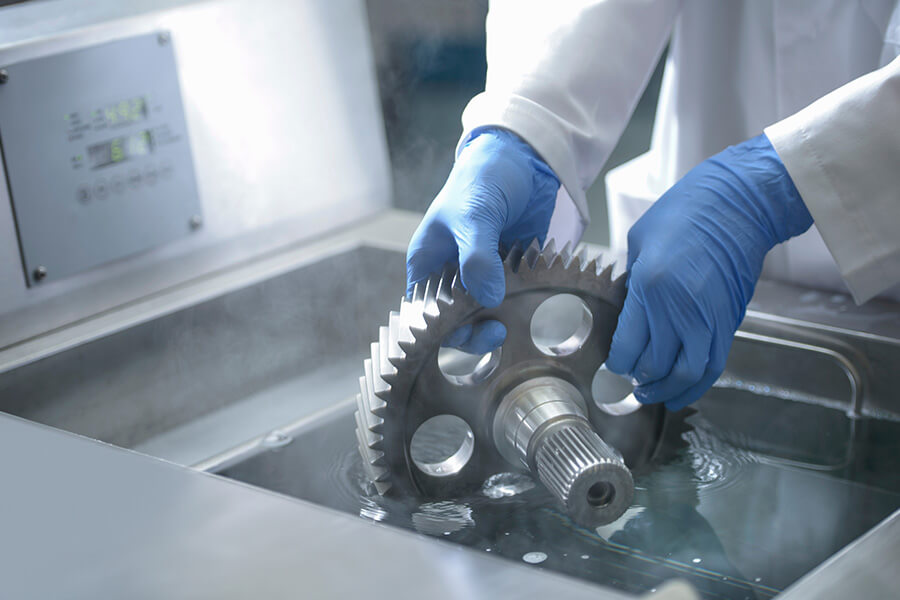Surface treatment of cast products is a critical step in the manufacturing process, enhancing the performance, durability, and aesthetics of the final components. By improving surface quality, increasing resistance to wear and corrosion, and reducing surface roughness, surface treatment ensures that castings meet the stringent requirements of various industries. This article explores the importance of surface treatment, the techniques used, their applications, and the challenges faced in achieving optimal results.
1. Importance of Surface Treatment in Casting
Surface treatment addresses several critical aspects of cast products:
- Surface Quality: Cast products often exhibit rough surfaces, impurities, and defects such as inclusions or porosity. Surface treatment improves smoothness and removes imperfections.
- Wear Resistance: Treating the surface increases hardness and resistance to abrasion, extending the component’s service life.
- Corrosion Resistance: Protective coatings and treatments shield the casting from environmental factors such as moisture, chemicals, and temperature fluctuations.
- Aesthetic Appeal: Surface finishing enhances the appearance of the product, which is crucial for components with visible surfaces.
- Dimensional Precision: Some treatments, such as machining and polishing, refine dimensions, ensuring the product meets tight tolerances.
2. Common Surface Treatment Techniques
Surface treatment methods vary based on the material, application, and performance requirements of the cast product.
2.1. Mechanical Treatments
Mechanical treatments are widely used to improve the surface finish and remove imperfections.
- Grinding and Polishing: These processes remove excess material and achieve a smooth surface finish. Polishing can also enhance the appearance of the product.
- Shot Blasting: By propelling abrasive particles at high speed, shot blasting removes scale, rust, and casting residues, leaving a uniform surface.
- Sandblasting: Similar to shot blasting, sandblasting uses sand particles to clean and texture the surface. It is ideal for preparing the surface for subsequent coatings.
- Deburring: This process eliminates sharp edges and burrs, improving safety and aesthetics.
2.2. Chemical Treatments
Chemical treatments modify the surface properties through chemical reactions.
- Pickling: Acids are used to remove oxides, scale, and impurities, leaving a clean surface. Commonly used acids include sulfuric acid and hydrochloric acid.
- Electroplating: This involves depositing a thin layer of metal, such as chrome, nickel, or zinc, onto the casting to enhance corrosion resistance and appearance.
- Anodizing: Primarily for aluminum castings, anodizing forms an oxide layer that improves hardness and resistance to wear and corrosion.
- Chemical Conversion Coating: This process creates a protective layer, such as phosphate or chromate, to improve corrosion resistance and paint adhesion.
2.3. Heat Treatments
Heat treatments enhance surface hardness and mechanical properties.
- Case Hardening: Techniques such as carburizing or nitriding increase the surface hardness while maintaining a tough core.
- Induction Hardening: The surface is rapidly heated and quenched, resulting in a hardened layer.
- Tempering: After quenching, tempering reduces brittleness and improves toughness.
2.4. Coating Applications
Surface coatings provide an additional layer of protection and functionality.
- Paint and Powder Coating: These are commonly used for corrosion protection and aesthetic enhancement.
- Thermal Spray Coatings: Metals, ceramics, or polymers are sprayed onto the surface to improve wear and corrosion resistance.
- Epoxy Coatings: Epoxy resins provide a durable, chemical-resistant layer suitable for harsh environments.
3. Applications of Surface-Treated Cast Products
Surface-treated castings are employed across various industries to meet specific performance criteria.
- Automotive Industry: Engine blocks, brake discs, and gear housings undergo treatments like painting, shot blasting, and anodizing to improve durability and performance.
- Construction: Cast iron pipes and structural components are coated to prevent corrosion and extend their lifespan.
- Aerospace: High-precision castings such as turbine blades require surface treatments like thermal spraying and polishing for optimal performance.
- Machinery: Machine tool components use treatments like grinding, plating, and heat treatment to ensure dimensional accuracy and wear resistance.
- Energy Sector: Castings for pumps, valves, and turbines are treated with coatings to withstand high pressures and corrosive environments.
4. Challenges in Surface Treatment of Cast Products
Despite its benefits, surface treatment of cast products involves several challenges:
- Surface Defects: Casting defects such as porosity or inclusions can compromise the effectiveness of surface treatments.
- Material Compatibility: Some treatments may not be suitable for specific materials, requiring customized solutions.
- Cost Considerations: Advanced treatments like thermal spraying or electroplating can be expensive, impacting the overall production cost.
- Environmental Concerns: Chemical treatments often involve hazardous substances, requiring strict adherence to environmental regulations.
- Process Control: Achieving uniform and consistent results demands precise control over treatment parameters.
5. Innovations and Future Trends
Advances in surface treatment technologies are addressing current limitations and expanding possibilities:
- Laser Surface Treatment: This cutting-edge technology modifies surface properties with high precision, enhancing wear resistance and surface hardness.
- Nanocoatings: Nanotechnology enables ultra-thin, high-performance coatings with exceptional resistance to wear, corrosion, and heat.
- Eco-Friendly Treatments: Green alternatives, such as water-based coatings and biodegradable chemicals, are gaining traction to reduce environmental impact.
- Digital Simulation: Predictive modeling and simulation tools help optimize surface treatment processes, ensuring efficiency and quality.
6. Conclusion
Surface treatment is an indispensable part of the casting process, enhancing the functionality, longevity, and appearance of cast products. From mechanical and chemical treatments to advanced coating technologies, surface finishing ensures that castings meet the diverse requirements of modern industries.
While challenges such as cost, environmental impact, and defect management persist, ongoing innovations and research are paving the way for more efficient and sustainable solutions. By selecting the appropriate surface treatment based on the material, application, and performance criteria, manufacturers can unlock the full potential of their cast products, ensuring they deliver value across a wide range of applications.

